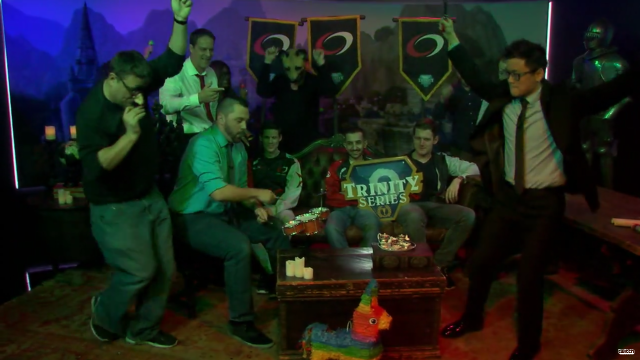Hearthstone is often thought of as a one-on-one card game, but in the Trinity Series, teams battle each other rather than single players. In the final matches of the tournament this weekend, four teams converged to see whose decklist could outlast the others.
Where most Hearthstone tournaments bracket individual players into a best-of-five format, having to win three games with each of their three decks, the Trinity Series pits teams of three against each other. Every team submits one deck for each of Hearthstone‘s nine classes, forcing them to vary it up beyond the standard competitive archetypes like Warrior and Shaman.
The real highlight is that the teams get to discuss and chatter during each play, and ESL, the tournament organiser, has them mic’d up for every match. Every match, interspersed with the commentators’ banter, is the actual discussion and thought process going on in these Hearthstone pros’ heads, as one plays and the other two backseat-coach.
This insight results in incredible insight into the player’s mindset, as they have to discuss out-loud what they’re thinking. It makes Hearthstone seem a little less like guesswork, and more akin to strategy or professional poker, in both the long-term card tracking (have they played their impact cards yet?) and in the short-term gambling for results. Take the clip below of Complexity, after betting on Virtus.Pro being unable to clear a Brann off the board:
Complexity had a Twilight Drake in-hand the turn prior, a card that gains health based on the amount of cards in your hand when you play it. Brann, a legendary card, makes it so effects like the Drake’s trigger twice whenever he’s on the board. In the last game of the series, Complexity was betting that VP didn’t have the resources or luck to clear Brann off the board in a single turn.
For several classes, the format allowed teams to run gimmick decks built around odd mechanics to win. Luminosity, in its semi-final match against Virtus.Pro, ran a complicated Druid gimmick deck relying on the minute interactions between several different cards.
Combining Avianna’s ability, which makes all minions cost one mana, and Kun, a card that refreshes your mana crystals when played, Luminosity could then dump out two mana-expensive minions that boost spell power significantly at little cost. Followed up by a few spells using the last of their remaining mana, they took Virtus.Pro from 27 to 0 in a single turn.
The Trinity Series was a unique tournament, in that by opening up the communication and thought process to the spectator, it made the game more intriguing and approachable for the viewer. Instead of spending each turn guessing at what they would do, you can hear the thought process play out — learning why they chose certain cards over others, or what their long-term game plan is — resulting in matches that are compelling even for those who don’t play Hearthstone at a competitive level.
Complexity went on to beat Luminosity 6-4, netting a prize of $US75,000 ($97,440). No plans have been set yet for a second season of the Trinity Series, but with all the crazy cards coming in the Un’Goro expansion, one can only hope we’ll get to hear Complexity’s Jan “SuperJJ” Janßen freak out over more miracle draws and massive Twilight Drakes.

Comments